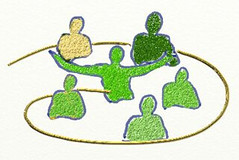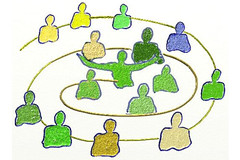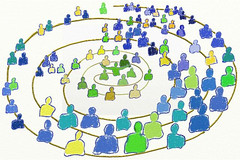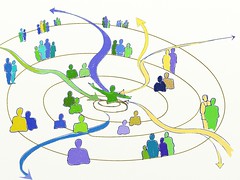


Just about a year ago, I posted an article on the work that Christopher Allen had done on:
- optimal size of groups for sustainability and collaborative effectiveness (short answer: around 5-7 for work groups and around 50 for networks/communities), and
- maximal span of any one person’s relationship ‘circles’
Christopher illustrated his answer to the second issue (the one this article is about) with the lovely drawings of Nancy Margulies, shown above, of three concentric circles/spirals, which he called, respectively, the support circle, the sympathy circle, and the trust circle. He argued that there are rivers or threads running through all three circles representing common ‘context’ for these relationships (work, shared philosophy or beliefs, kinship, love etc.), what he calls ‘geographies of connection’ on the topographical map of our relationships. Here’s Nancy’s illustration of these threads:

Over the last week, I’ve been chatting with Tree Bressen, Rob Paterson, Melinda Fleming and Nancy White about how many meaningful relationships we can sustain without exhaustion. I hypothesized that (based on people I know) most people have either 5-7 really close (family/love/other partnership) relationships that essentially take up all of their social time, or they have somewhere north of 50, almost all more tenuous, relationships. In either case there’s a constant struggle I would argue, to give and get the aggregate attention and appreciation one wants from one’s social network.
The prevailing view is that we can (and do) have both — an intimate inner circle and a more tenuous second and third circle (or perhaps there are more circles, or perhaps it’s just one continuous outward spiral with strong links at the centre and weak links further out). But my observation is that very very few people really have both, and that people are pretty willing to give up on their large networks if they can find what they want in their inner circle. There’s a constant tension, though — since that inner circle is “putting all one’s eggs in one basket” there is a risk of losing those relationships and not being able to replace them, so many people, I think, try to keep that larger network ‘in reserve’ as a safety net(work).
Because we only have a limited number of hours per year for social activity (take away sleep etc., work time and time wanted for solitary activities and I’d guess we each have between 1500 and 3000 hours a year of social time to parse out), cultivating our networks (which are largely outside our control) can be hugely challenging.
And on top of all this, some of us (sensibly I think) are trying to rediscover or maintain another essential relationship, to Gaia, to all-life-on-Earth, to the natural world. For most of us there is a huge disconnect here — the people in our circles, like we ourselves, live outside the natural world (both physically and especially psychologically) so there is no context of place in which to situate and ‘make sense’ of these relationships. There is, in short, no real community. The relationships, and the attention and appreciation that draw us to others and others to us, are substantially all in our heads.
I have said before that I think humans were and are meant to live a tribal, place-based life as part of community and of all-life-on-Earth. In that natural, prehistoric, and now ideal and unachievable world, we are, at a certain age of adulthood, given the choice of asking to be invited to join the community in which we grew up, or leaving the community and seeking another that gives our life more meaning and value. We can be a part of a community, or we can live peripherally to it, as a visitor or traveler or nomad, until we find the place and community (the two are largely inseparable) where we know we belong. In the natural and prehistoric world one is always a part of the greater circle of all-life-on-Earth, so even those who live on the periphery of community still feel a larger belonging, connection, and appreciation. But there is relatively little choice in such a world of who we can choose to live in community with. Most natural tribes (and not just in human societies) have significant buffer zones between them, and a certain Darwinian reticence to accept strangers. One earns one’s place in a community, and the relationships with the tribe naturally follow.
My Gravitational Community — the 50-70 people listed in the right sidebar — has evolved over the years but stayed roughly the same size. As some of the people who have come into my ‘orbit’ have become much closer to me, the attention I have for the rest (manifested mainly through this blog, IM, e-mail and Second Life) inevitably wanes and these relationships tend to weaken and ‘fall out of orbit’. I wonder if there’s a Quantum Theory for social networks, a ‘rule’ that determines, based on your total social time and energy and on the number of people in various levels of intimacy or proximity to you, how many ‘spaces’ are left in the outer orbits?
If all your relationships are shallow, I can envision you having 150 (Dunbar’s number) such relationships, and juggling them competently. At the other end of the spectrum, I suspect the maximum number of sustainable meaningful relationships for newlyweds and new mothers is between 1 and 2. Perhaps an inverse-square law applies. And then, as we all struggle with Tom Robbins’ great question How do we make love last?, some of those inner circle covalent relationships slide out to outer circles or out of orbit entirely, making room for either a host of new outer-orbit relationships or a new ‘one and only’.
It will not come as a surprise to my regular readers that I believe we are naturally polyamorous, and that there is more strength and sustainability in an set of 3-7 covalent relationships that are intimate and loving and appreciative and attentive but not exclusive, not demanding of the lion’s share of one’s time, and full of accommodation and compersion for each partner. These relationships (especially in today’s world) need not be reciprocal — each of the 3-7 others one has a poly relationship with may have 3-7 other relationships, such that the total poly network could involve dozens of people. This provides a lot more flexibility and support than can be expected from any monogamous relationship. But it is a lot of work, especially when the relationship members live far apart.
My Gravitational Community is broken down into categories that show how the people with whom I have meaningful relationships came into my life, but it would probably be more honest if I were to categorize them by what draws me to them (and hopefully, them to me): that draw may be emotional/visceral/erotic appeal, shared purpose or ideals, or any of three types of intellectual appeal (great intelligence, great creativity, or great communication skill or other attractive competency). Think of these appeals or ‘geographies of connection’ as spokes or rivers flowing out from the centre, as a second dimension (along with ‘quantum level’) of the ‘map’ of one’s social network. Might be a little too personal and too revealing to show for the Gravitational Community on my right sidebar though!
Please feel free to join the dialogue, and let me know if and how you think it’s possible to have it both ways — the ‘cold fusion’ of a fulfilling and intimate inner circle as well as a large and diverse and dynamic ‘outward spiral’ of people with whom one also manages to sustain an enduring and meaningful relationship.
And also please let me know if you have thoughts on how it might be possible to somehow ‘situate’ the people you have important relationships with, within the larger relationship we all have (but have largely forgotten) with all-life-on-Earth. To meld and merge all these juggled relationships into real communities.





Pingback: Too Many Blackberrys « ColdSip.com
Pingback: uberVU - social comments
Hi Dave —
I think the answers to your final questions are all contained within your graphics and text, you just shied away from putting it out there boldly.
Real community requires *place* in order to be… what?… complete? Is that a good word for it? Maybe.
Deep Relationship… intimacy whether physical, intellectual, emotional or a combination… requires *time* to develop and to maintain.
Even the most casual social relationships… I’m thinking here about “people you know” without any real relationship behind it at all… even these take time to develop and time to maintain. (For example, people I considered “regular customers” at my job. Maybe don’t even know their names, I just know them in that context. Now that I no longer have that job, if I don’t see them for a period of time, it will be very awkward to even walk up and say hi on the street. Because the relationship was not developed enough to go beyond basic awareness, and once I am no longer engaging them regularly, that dawning relationship will fizzle.)
So… if the goal is to build a strong, intimate core, with a spiral of gradually less intimate social relationships the only way to make that really work — especially with a place-relationship — is to have a community, tied to a place, with constantly overlapping interactions. Work, play, life in general, must be integrated with the group and the place.
hmmmm…. I need to think on this a little more to put my words together… but I will…. :-)
Janene
Hey —
I dunno why its not piging automatically… but here you go: http://terrapraeta.wordpress.com/2010/03/11/time-well-spent/
J
Answer to your question: zero.
The title of this post ouched me; perhaps “managing relationships” is an oxymoron. Perhaps managing is exactly the wrong metaphor. I’d try “tending”.
Manage objects. Love people. Tend to relationships.
(perhaps I’ve experienced too much burning from efforts at third-party relationship-management)
Now how many relationships can I consistently tend to? This is quite and urgent question for me as part of an intentional community, which is just slightly too big to let tending every relationship be humanly possible. I only just realised this, so thankyou.
By the way, it’s really meant heaps to me just having my name sitting there in your gravitational community list. Your little gestures of recognition can mean so much, when many of us have struggled in environments where recognition is a long time coming.
Don’t underestimate the potential for intimate and meaningful relationship via small gestures. The potential here is limitless.
John, thank you for the strike against “management!” I quite agree. How many people are in your IC?
I recently wrote an essay on the band, incl. optimal size.
http://leavingbabylon.wordpress.com/2010/01/23/strike-up-the-band/
Would love to have your comment on it on the blog.
Hi vera – sixteen houses in the IC I live in. Thanks for the link to your blog – I won’t promise to comment as I get stretched for energy to read and write in front of a computer.
John
this is good but it disregards an essential difference between kinds of people.
the models would not be the same for introverts & extraverts; & i suspect that each of the 16 Jungian types has its own specific social needs.
because the types are not equally prevalent, the more common ones’ needs “drown out” the perceptibility of the needs of the less common types (some are 100 times more common than others).
you might rather look at it from the point of view of the ideal tribe, which would (say) have one of the very least common types, but no more than their fair number of the most common types; but what happens in today’s world, is a mediated sorting-out of like with like, so that grossly unbalanced tribes form, with a consensus that is biased toward things it is easy for those of that type to believe.
this is how we end up so deluded en masse.
John, theoretically 16 houses seems well within the band monkeysphere… what makes it too many?
Pingback: What quantum computers may tell us about quantum mechanics … | Wave Mechanics Material Geek
This is quite interesting. I very much agree with the general thrust . . . it seems that one person you’re quite close to takes up emotional space, energy and so forth, as well as time, as much as quite a few people you’re not very close to. If you have the core group, finding time for a lot of less intimate relationships will be harder; try to maintain both and you will end up, in Bilbo Baggins’ words, feeling “stretched, like butter scraped over too much bread”. And for quieter people, there may not even be much desire to maintain a broad network if one has a close group. So on the question, “Is it possible to have it both ways?” . . . Even if it’s possible, is it desirable? What’s the aim? Does this discussion implicitly take something like “maximum practical total amount of intimate social closeness” as a goal, good by definition?
But I do agree with graywyvern–not everyone is the same. There do seem to be people who really prefer having a large number of not-so-close relationships, and other people who absolutely cannot stand dealing with large numbers of acquaintance-level relationships. There are party people and run-screaming-from-parties people. So while some people probably have large groups of acquaintances because they haven’t built up the intimacy and trust with a smaller group to be able to move the rest to orbits further out, others I don’t think it’s so–juggling wider groups is really their natural or preferred state.
I suspect the same is true of polyamory, including non-exclusive overlapping polyamory. Some “we” may be naturally suited to it, perhaps not realizing it because of cultural overlay. I’ve certainly known some people who really seem suited to that sort of relationship. Other “we” probably really isn’t. Personally, all issues of exclusivity, whether jealousy is innate or culturally mandated etc. aside, I’m just not sociable enough to be able to handle multiple intimate partnerships at once. I mean, you talk about most people having 5-7 really close relationships that take up all of their social time. Then you consider an ideal involving 3-7 amorous ones, which either leaves between 0 and 2 for family and friends or implies overload. Plus, all the amorous ones are in flux and leading to other complex connections. I’d go nuts. If I could jettison all my cultural baggage (and get some other cultural baggage appropriate to the project), I could maybe handle two. Maybe. For a few months at a time. For me, I think the “lots of work” you point to would just be too much, the extra support you describe just not worth it–to me, some time to reflect on my own is extremely important, while I only need so much support network. Different people’s needs and tradeoffs are different.
Janene talks about the importance of place, and of some kind of unified community in which relationships in different spheres overlap. I’m not sure how important I think that is. I have a group of friends I get together with one evening a week to indulge a common interest. I’m pretty close to them. We trust each other, we know that we’d be there for each other if we really needed help although we’re all the sort who would be hesitant to ask. I don’t normally see them in any other context. I guess I’d be happy if I did run into them at other times, but it’s not important–we don’t need that to be close. I could theorize that there is something incomplete about this relationship, but that’s all I’d be doing–I can’t come up with any actual feelings or intuitions of dissatisfaction on which to hang such theories. Even in something like a tribe, might be your hunting buddy would be a different person from your talk-about-legends buddy. Holism can be taken too far–I think people have a built in tendency to divide things (including relationships) into categories, and while that tendency holds risks it also has a great deal of value.
I have typically had a small to nonexistent “peripheral” circle, as I tend to focus on family much more than work colleagues or other friends. Either I have very high expectations of what friendship is, or I just find a lot of what people talk about to not be very interesting. In my experience, the people that are most important are the ones you can always reconnect with, possibly after months of no interaction, and feel that no time has actually passed. You might have seen a lot of them at one point in your life, but you don’t lose what you have. It’s quite obvious when you say, exchange one set of work colleagues for another. The important people (if there were any) are quite obvious after a short while. The same might apply to moving house and changing neighbourhoods.
Still the sense of community being linked to place is rather elusive the way things are in society at the moment. I’d like to be in a place where I had at least some interaction with locals because it just happens that locals are people you’d go to for your essentials rather than a big shop in the next town.
It just occurred to me that the visualisations above might be too centered on the individual, where in fact what we’re looking at is a networked set of interactions, and often people keep relationships going via intermediaries relaying information, so in fact it isn’t a case of “managing” a list of associations, rather it often happens without your personal effort because another person is acting as the “glue”.
human “glouns” in your quantum theory of relationships there. This is probably quite important in my world, as I can think of very obvious people in my life that have this kind of role.
Hi Dave,
It’s all about “locality”, or as the first commenter said: “place”.
Surround ourselves with the people we care about in the place where we live, or at least that we can walk (or bike) to.
Cheers,
Randall.
Pingback: aslkdjskldj « intrinsicallymotivated
I have gotten lost again. In my quest to make a living, I have forgotten why I’m living.
In my core I know it’s all about a connection to each other. Maybe there is a way to make it much easier to do. We simply need to do our best to be of service to the people who come into our life. The closest of those relationships will be the ones we spend the majority of our time with by choice or nature and give our whole hearts to.
Thanks for the hand back up!